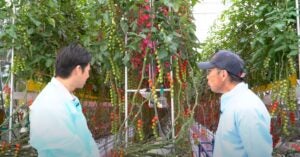At two Toyota plants, cherry tomatoes are now in cultivation, while the strawberry harvest is in full swing. But, why is an engine plant planting strawberries?
While the carmaker is trying to achieve carbon neutrality by 2035, their latest step in reducing greenhouse gas emissions is to produce fruit at two of its Japanese facilities. The Kamigo plant is responsible for manufacturing engines for Crown and Lexus models and has added four varieties of strawberries to propagate. Meanwhile, the Miyoga plant has set up a greenhouse dedicated to growing cherry tomatoes.
“Our production facilities inevitably emit heat and CO2, which are sustenance for plants,” comments an article in Toyota Times. “Waste heat and CO2 normally have a negative environmental impact, and the idea was to find a productive use. This approach also brings economic benefits, including lower fuel costs.”

In April 2022, with assistance from farmers, Toyota set up experimental greenhouses inside their plants. A special system enables the greenhouse to produce about a time and a half the yield of a similarly-sized field.
Strawberries, for example, are cultivated in sliding rows that reduce the required number of aisles, leaving more room to cultivate more strawberries.
Participating in agriculture endeavors isn’t new to the company, which already provides support in growing rice, barley, and soybeans.
However, Toyota has no interest in produce markets. Instead, the crops are grown and offered free to workers in the Toyota cafeterias. And Toyota hopes some of its innovations may help boost farmers’ profitability and efficiency.
“We’re not here to take farmers’ jobs — we want to help them by building efficient agricultural systems and providing other forms of technical support,” explains Hiroshi Okajima, project general manager for Toyota’s R&D and engineering management division.
»Related: The gap under a spray rig should never be a driving lane


